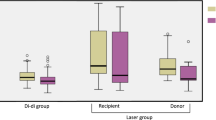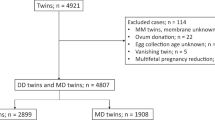Abstract
Objective:
To assess renin, aldosterone, human atrial natriuretic peptide (hANP) and brain natriuretic peptide (BNP) levels in cord blood from monochorionic diamniotic (MD) twins with a birthweight (BW) discordance that do not satisfy the criteria of twin-to-twin transfusion syndrome (TTTS).
Study Design:
Cord blood samples were obtained from 28 MD twins without TTTS. They were divided into two groups on the basis of BW discordance as follows: large (>7.5%) and small (⩽7.5%). Cord blood renin, aldosterone, hANP and BNP levels were measured.
Result:
Renin levels in MD twins with a large BW discordance were significantly higher than those in MD twins with a small BW discordance, with no significant differences in aldosterone, hANP and BNP levels. A significant correlation was found between renin levels and BW discordance.
Conclusion:
Renin is activated in MD twins with a BW discordance of >7.5%, even in non-TTTS.
This is a preview of subscription content, access via your institution
Access options
Subscribe to this journal
Receive 12 print issues and online access
$259.00 per year
only $21.58 per issue
Buy this article
- Purchase on Springer Link
- Instant access to full article PDF
Prices may be subject to local taxes which are calculated during checkout


Similar content being viewed by others
References
De Paepe ME, Shapiro S, Young L, Luks FI . Placental characteristics of selective birth weight discordance in diamniotic-monochorionic twin gestations. Placenta 2010; 31: 380–386.
Lewi L, Gucciardo L, Van Mieghem T, de Koninck P, Beck V, Medek H et al. Monochorionic diamniotic twin pregnancies: natural history and risk stratification. Fetal Diagn Ther 2010; 27: 121–133.
Denbow M, Fogliani R, Kyle P, Letsky E, Nicolini U, Fisk N . Hematological indices at fetal blood sampling in monochorionic pregnancies complicated by feto-fetal transfusion syndrome. Prenat Diagn 1998; 18: 941–946.
Brewster UC, Setaro JF, Perazella MA . The renin-angiotensin-aldosterone system: cardiorenal effects and implications for renal and cardiovascular disease states. Am J Med Sci 2003; 326: 15–24.
Yasue H, Yoshimura M, Sumida H, Kikuta K, Kugiyama K, Jougasaki M et al. Localization and mechanism of secretion of B-type natriuretic peptide in comparison with those of A-type natriuretic peptide in normal subjects and patients with heart failure. Circulation 1994; 90: 195–203.
Mahieu-Caputo D, Dommergues M, Delezoide AL, Lacoste M, Cai Y, Narcy F et al. Twin-to-twin transfusion syndrome. Role of the fetal renin-angiotensin system. Am J Pathol 2000; 156: 629–636.
Mahieu-Caputo D, Meulemans A, Martinovic J, Gubler MC, Delezoide AL, Muller F et al. Paradoxic activation of the renin-angiotensin system in twin-twin transfusion syndrome: an explanation for cardiovascular disturbances in the recipient. Pediatr Res 2005; 58: 685–688.
Bajoria R, Ward S, Sooranna SR . Atrial natriuretic peptide mediated polyuria: pathogenesis of polyhydramnios in the recipient twin of twin-twin transfusion syndrome. Placenta 2001; 22: 716–724.
Van Mieghem T, Done E, Gucciardo L, Klaritsch P, Allegaert K, Van Bree R et al. Amniotic fluid markers of fetal cardiac dysfunction in twin-to-twin transfusion syndrome. Am J Obstet Gynecol 2010; 202: 48.e41–e47.
Galea P, Barigye O, Wee L, Jain V, Sullivan M, Fisk NM . The placenta contributes to activation of the renin angiotensin system in twin-twin transfusion syndrome. Placenta 2008; 29: 734–742.
Branum AM, Schoendorf KC . The effect of birth weight discordance on twin neonatal mortality. Obstet Gynecol 2003; 101: 570–574.
Quintero RA, Morales WJ, Allen MH, Bornick PW, Johnson PK, Kruger M . Staging of twin-twin transfusion syndrome. J Perinatol 1999; 19: 550–555.
Ogawa Y, Iwamura T, Kuriya N, Nishida H, Takeuchi H, Takada M et al. Birth size standards by gestational age for Japanese neonates. Acta Neonatol Jpn 1998; 34: 624–632 (In Japanese).
Tsuchiya K, Yoshimoto T, Hirata Y . Endothelial dysfunction is related to aldosterone excess and raised blood pressure. Endocr J 2009; 56: 553–559.
Kato K, Murakami H, Isozaki O, Tsushima T, Takano K . Serum concentrations of BNP and ANP in patients with thyrotoxicosis. Endocr J 2009; 56: 17–27.
Demissie K, Ananth CV, Martin J, Hanley ML, MacDorman MF, Rhoads GG . Fetal and neonatal mortality among twin gestations in the United States: the role of intrapair birth weight discordance. Obstet Gynecol 2002; 100: 474–480.
Minakami H, Honma Y, Matsubara S, Uchida A, Shiraishi H, Sato I . Effects of placental chorionicity on outcome in twin pregnancies. A cohort study. J Reprod Med 1999; 44: 595–600.
Gohlke BC, Huber A, Bartmann P, Fimmers R, Hecher K, Bouret SG et al. Cord blood leptin and IGF-I in relation to birth weight differences and head circumference in monozygotic twins. J Pediatr Endocrinol Metab 2006; 19: 3–9.
Gohlke BC, Huber A, Hecher K, Fimmers R, Bartmann P, Roth CL . Fetal insulin-like growth factor (IGF)-I, IGF-II, and ghrelin in association with birth weight and postnatal growth in monozygotic twins with discordant growth. J Clin Endocrinol Metab 2005; 90: 2270–2274.
Gohlke BC, Bartmann P, Fimmers R, Huber A, Hecher K, Roth CL . Fetal adiponectin and resistin in correlation with birth weight difference in monozygotic twins with discordant growth. Horm Res 2008; 69: 37–44.
Morcel K, Lavoue V, Beuchee A, Le Lannou D, Poulain P, Pladys P . Perinatal morbidity and mortality in twin pregnancies with dichorionic placentas following assisted reproductive techniques or ovarian induction alone: a comparative study. Eur J Obstet Gynecol Reprod Biol 2010; 153: 138–142.
Gratacos E, Lewi L, Munoz B, Acosta-Rojas R, Hernandez-Andrade E, Martinez JM et al. A classification system for selective intrauterine growth restriction in monochorionic pregnancies according to umbilical artery Doppler flow in the smaller twin. Ultrasound Obstet Gynecol 2007; 30: 28–34.
Russell Z, Quintero RA, Kontopoulos EV . Intrauterine growth restriction in monochorionic twins. Semin Fetal Neonatal Med 2007; 12: 439–449.
Kondo Y, Hidaka N, Yumoto Y, Fukushima K, Tsukimori K, Wake N . Cardiac hypertrophy of one fetus and selective growth restriction of the other fetus in a monochorionic twin pregnancy. J Obstet Gynaecol Res 2010; 36: 401–404.
Tsyvian PB, Markova TV, Mikhailova SV, Hop WC, Wladimiroff JW . Left ventricular isovolumic relaxation and renin-angiotensin system in the growth restricted fetus. Eur J Obstet Gynecol Reprod Biol 2008; 140: 33–37.
Grigore D, Ojeda NB, Robertson EB, Dawson AS, Huffman CA, Bourassa EA et al. Placental insufficiency results in temporal alterations in the renin angiotensin system in male hypertensive growth restricted offspring. Am J Physiol Regul Integr Comp Physiol 2007; 293: R804–R811.
Ojeda NB, Royals TP, Black JT, Dasinger JH, Johnson JM, Alexander BT . Enhanced sensitivity to acute angiotensin II is testosterone dependent in adult male growth-restricted offspring. Am J Physiol Regul Integr Comp Physiol 2010; 298: R1421–R1427.
Acknowledgements
This research was supported by the Support Program for Improving Graduate School Education from the Ministry of Education, Culture, Sports, Science and Technology in Japan (KF), and grants for Scientific Research from the Morinaga Hoshi-kai Foundation and the Ministry of Education, Culture, Sports, Science and Technology in Japan (KF and IM).
Author information
Authors and Affiliations
Corresponding author
Ethics declarations
Competing interests
The authors declare no conflict of interest.
Additional information
Author contributions
All authors (KF, IM, AM, TY, KM, SM, ME, AS, MMo, NY, HY and MMa) contributed to the intellectual content of this manuscript. KF, IM, AM, TY, KM, SM, ME, AS, NY and MMa were neonatologists of the patients and collected the clinical data. KF, IM, AM, TY, KM, SM and AS measured plasma renin activity, hANP and BNP, and serum aldosterone levels. KF, IM and ME performed statistical analysis of the data. MMo and HY were obstetricians and collected the cord blood samples of the patients.
Rights and permissions
About this article
Cite this article
Fujioka, K., Morioka, I., Miwa, A. et al. Renin is activated in monochorionic diamniotic twins with birthweight discordance who do not have twin-to-twin transfusion syndrome. J Perinatol 32, 514–519 (2012). https://doi.org/10.1038/jp.2011.136
Received:
Revised:
Accepted:
Published:
Issue Date:
DOI: https://doi.org/10.1038/jp.2011.136



